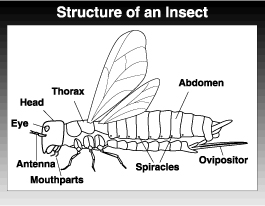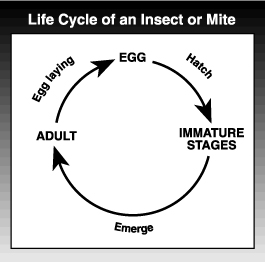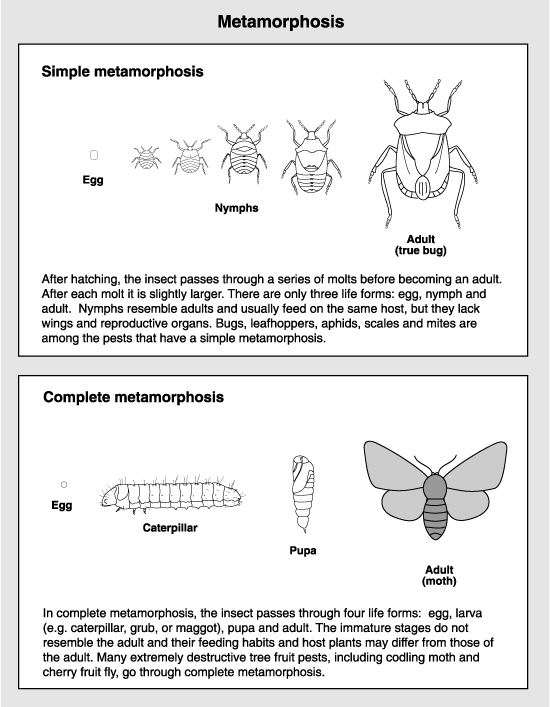by Elizabeth H. Beers and Geraldine Warner, originally published 1993
Insects and mites belong to a large group of animals known as arthropods. Several characteristics differentiate insects from other arthropods. The body is segmented, and the segments are grouped into three sections: head, thorax and abdomen. The eyes, antennae and mouthparts are on the head, and the legs and wings are on the thorax.
 In contrast, mites have no antennae, and adult forms usually have four pairs of legs. The head and thorax are smaller and fused in mites. The abdomen is relatively large and bulbous and is not distinctly segmented.
In contrast, mites have no antennae, and adult forms usually have four pairs of legs. The head and thorax are smaller and fused in mites. The abdomen is relatively large and bulbous and is not distinctly segmented.
An insect’s skeleton is on the outside of its body and is called an exoskeleton. It serves as a support for muscles and internal organs as well as a covering. The body wall of an insect has three layers. The outer layer is cuticle containing chitin, proteins and often pigments. This is secreted by a cellular layer beneath it called the epidermis. The inner layer is called the basement membrane.
The type of mouthparts an insect has determines how it feeds and what sort of damage it does. There are two general types: chewing and sucking. Insects with sucking mouthparts suck liquid food through an elongated beak. Insects with chewing mouthparts tear off pieces of host tissue and ingest it.
 Growth progresses through successive stages. Females lay eggs, which hatch into an immature stage. After passing through a series of immature stages, the insect emerges as an adult. Adults mate and the cycle begins again.
Growth progresses through successive stages. Females lay eggs, which hatch into an immature stage. After passing through a series of immature stages, the insect emerges as an adult. Adults mate and the cycle begins again.
Most insects start as eggs, which vary in size, shape and color. They can be deposited singly or in compact masses but are usually protected in some way. They may be laid in the ground or in or on plant tissue. Eggs left exposed are often protected from the elements and natural enemies by a coating.
Eggs may be round, oval, barrel shaped, disk shaped or suspended on long stalks. The tough outer surface protects the embryo and prevents water loss.
The first immature stage of the insect hatches from the egg. As the insect’s rigid exoskeleton cannot expand much, it must be shed and replaced with a larger one as the insect grows. This process is called molting. The life stage between each molt is called an instar.
Molting is governed by hormones. Cuticle secretion and the molt cycle are controlled by ecdysone, a steroid hormone. The hormone is secreted by a gland in the thorax, which is in turn controlled by a hormone from the brain. Whenever the brain receives the appropriate stimulus, the insect will molt. A new cuticle forms under the old one, then the old exoskeleton splits and the insect wriggles its way out. Many insects eat their own discarded skin. The new cuticle is soft at first. The insect may swallow air to expand its own volume and stretch the new exoskeleton before in hardens, usually within about an hour.
Metamorphosis
Most insects change in form during their development, and the successive stages are not all alike. This change in form is called metamorphosis. It is controlled by a juvenile hormone secreted by glands in the insect’s head. The juvenile hormone is released during each molt, but the amount decreases each time. As the concentration of juvenile hormone declines, more adult characters will appear until very little or no juvenile remains and the adult stage is produced. If the juvenile hormone is introduced at the wrong time or in the wrong amount during the insect’s life cycle, normal growth can be disrupted. Insect growth regulators use this principle for pest control (see section on Insect Growth Regulators). Some insects change very little in form, and the young and adults are similar except for size. This type of development is known as simple metamorphosis. The young, which are called nymphs, usually share the same habitat and feed on the same host as the adults. Nymphs lack wings and reproductive organs. Aphids and leafhoppers are among the insects that go through simple metamorphosis, as do mites.
Some insects have young and adults that are quite different in appearance from each other and often live in different habitats. This type of development is known as complete metamorphosis. The young are called larvae. Larvae generally have chewing mouthparts, even when the adults have sucking mouthparts. The larva goes through a series of stages, finally transforming into a pupa before becoming an adult. The pupa does not feed and is usually inactive. Many insects pass the winter in the pupal stage before emerging as adults.
Insects that go through complete metamorphosis include moths (whose larvae are caterpillars), flies (whose larvae are worms or maggots) and beetles (whose larvae are grubs). The metamorphosis of some insects is somewhere between simple and complete. These include thrips and male scale insects.
The length of a generation and how it is influenced by the seasons varies from insect to insect. Many insects have one generation each year. However, some beetles and moths need two or three years to complete one generation. Other insects have more than one generation each year. In some cases, the insect has a constant number of generations. In others, the number of generations may vary depending on the climate. A few insects, such as aphids, have many generations each year and keep reproducing as long as the weather is favorable.
In most cases, the insect passes the winter in a state of dormancy. The overwintering stage can be the egg, nymph, larva, pupa or adult. Dormancy can last from days to years. It can be triggered either by environmental or genetic factors. Most insects go into dormancy when the weather becomes unfavorable and become active again when it turns favorable. Others will go into dormancy at a certain time of year before conditions become unfavorable. This is known as diapause. Diapause is often triggered by the shortening days as winter approaches. Many insects require a prolonged period of chilling before they will break diapause.
Reproduction in Insects and Mites
Reproduction in insects and mites can take a wide variety of forms, often very complex. Some can switch their type of reproduction during their life cycle based on environmental triggers. Others reproduce the same way throughout their life history. The basic theme, and some of the variations are described below.
Sexual reproduction
The standard model for reproduction is where males and females occur throughout the life cycle, and each produces a germ cell (egg and sperm, respectively). The male inseminates the female during mating. The female often stores sperm in special pouches in her abdomen called spermathecae (singular, spermatheca). The eggs are fertilized within the female’s body, producing an embryo. Eggs are deposited on a host. They hatch and develop into either male or female offspring.
Parthenogenesis
This is asexual reproduction, where eggs grow and develop without fertilization. There are several variations of parthenogenesis. Arrhenotokous parthenogenesis is where unfertilized eggs produce only males. In deuterotokous parthenogenesis, both males and females are produced from unfertilized eggs. In thelyotokous reproduction, unfertilized eggs produce only females. Spider mites, for example, undergo arrhenotokous parthenogenesis, where unfertilized eggs produce males and fertilized eggs produce females.
External insemination
Insects may reproduce by sexual means, but insemination occurs without mating. The males deposit spermatophores, which are packets of sperm, and the females extract the sperm from these packets by various means. Rust mites undergo external insemination.
Viviparity
Most insects deposit eggs that hatch into nymphs or larvae, a process called oviparity, but some insects bear living young. A common example are aphids, which are viviparous during part of their life cycle. A variation is ovoviviparity, where eggs are held within the female’s body, where they hatch, and the young are born live.
Polyembryony
This is where two or more embryos develop from a single egg, as in the parasitic Hymenoptera, such as braconid, encyrtid, and dryinid wasps. Typically, between two and several dozen embryos are produced, but some encyrtids can produce up to 1,500 embryos from a single egg.

